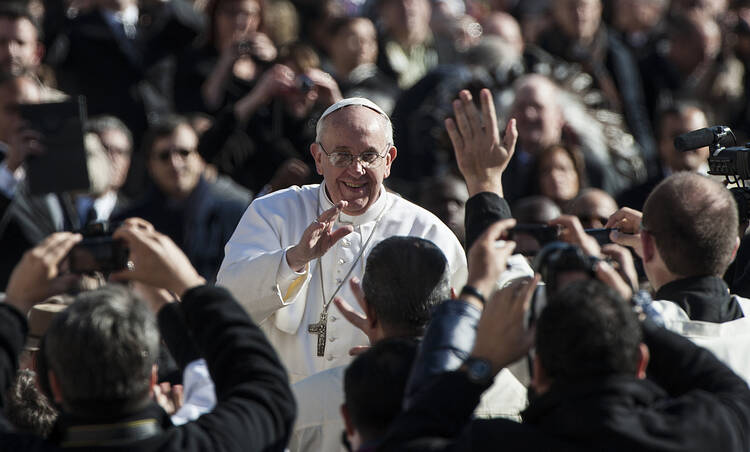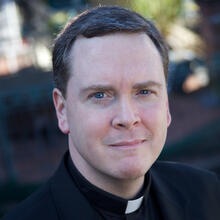Good day from Rome on the sixth day of the pontificate of Pope Francis. Nearly 200,000 Catholic pilgrims gathered under a brilliant blue sky in St. Peter's Square this morning to witness the installation of the former Jorge Mario Bergoglio, S.J. as the 266th successor of Saint Peter, marking the formal end of the beginning of this unexpected papacy. Also present were representatives of other Christian churches and communities, delegations from 132 countries, Jewish and Muslim leaders as well as Buddhists, Hindus, Sikhs and Jains.
Pope Francis preached the Gospel, but insisted that the values it espouses are essentially human, "involving everyone." He then asked the government leaders present and all those with responsibility in the field of economics, politics and social life to stand firm when destruction and death threaten human dignity, human life and the environment. As for the Petrine ministry itself, Pope Francis said that he realized that his new ministry included "a certain power," but that it is the same power Jesus conferred on St. Peter, which was the "power of service" seen in Jesus' charge to St. Peter: "Feed my lambs. Feed my sheep… Let us never forget that authentic power is service and that the pope, too, when exercising power, must enter ever more fully into that service which has its radiant culmination on the cross," he said.
Seated directly below the canopied altar, facing the façade of the basilica and just to the left of the statue of Saint Paul, I was about 20 feet from the pope when he entered the square. Standing in a modified open jeep, Francis appeared overwhelmed at first but quickly found his stride, bending over to kiss a baby and even leaving the pope mobile to greet a disabled man and his family. Frankly, if he hadn’t look a little uncomfortable, I would have been worried. A humble man should find such an experience at least initially unsettling.
As hard as it is to believe given the grandeur and beauty of the surroundings, the liturgy was actually a modest affair, many light years away from the papal coronations of old. In fact, the symbols of the papal office, the pallium (the white wool garment worn at the neck) and fisherman’s ring, were imparted to Francis in a brief rite before the Mass properly started in order to avoid any appearance that the papal installation is somehow sacramental. Other innovations included the prominent placement and participation of representatives of the separated orthodox churches and the proclamation of the Gospel in Greek, the language in which the texts were originally composed. In all, there were perhaps a dozen significant changes in the liturgy, every one of them for the sake of either simplicity or greater inclusion.
The crowd got it. They were moved by the new pope’s gestures. Not a few were in tears as they came forth for communion. I must say that, in my very short life as a priest, distributing communion at today’s liturgy is a high point. Not because of the surroundings, or the occasion, though both of those helped. No, it was the unity-in-diversity of the moment that was so moving, a truly Eucharistic moment. Every kind of human face was present at communion, every language could be heard between the loggias, every state of person was present: young, old, clerical, lay, fit and ill. Yet at the moment of communion, we were truly one church, one people of God. The Lord’s words, “that they may all be one,” were realized today in the piazza. “As you, Father, are in me and I am in you, may they also be in us, so that the world may believe that you have sent me.”
Amen. Thanks be to God.
After this dispatch, the temporary Rome bureau of America magazine will close its doors. Tomorrow I head back to the U.S. It feels like it’s been a year since I left New York only two weeks ago. Pope Benedict’s resignation announcement seems like a lifetime ago, though it’s only been a little more than a month. And what a month it’s been. No doubt the last thirty days have changed the church; in what way and to what degree remains to be seen. We who have lived through these days, however, could not help but be moved by them. It has been a privilege to accompany you through this amazing time. This past month has reminded me that we are in this together, you and I, and that we need not be afraid; the Holy Spirit is at work, sometimes imperceptibly, always salvifically, guiding our earthly pilgrimage through the gaudium et spes, as well as the painful struggles, of modern life. The church’s challenges are great, her scandals not few; but where “sin increased, grace abounded all the more.”
When I left America’s offices in midtown Manhattan, we were just about to ship the issue with a picture of Saint Peter’s on the cover. We chose to let the reader decide whether the sun was rising or setting over the basilica. I’ve made up my mind: a new day is breaking; hope, the One who is hope, still lives.
Thanks be to God.
- Catholic News Service contributed to this report.









Traditional is good, necessary. But not everything that's been added over the centuries is inseparable from the source, is it? Tradition comes in many shapes and sizes, colors and smells and textures. The essential message is far more simple than the constructs of theologians, liturgists, and scholars. Keep the beauty, the truth, but where elaboration gets in the way of the essential message, tone it down, or even - in extreme cases only - let it go.
Tradition, on the whole, should be preserved, but part of the work of preservation is keeping it alive, infusing it with new meaning. An ossified tradition can cease to be meaningful to living people; it can even, in its apparent meaninglessness, obscure the most important things. Hard choices, sometimes. Changes should never, I think, be made suddenly, wholesale, with disregard for the feelings of people and discounting the wisdom of experience, but in a Church that continues to live, they must be made.